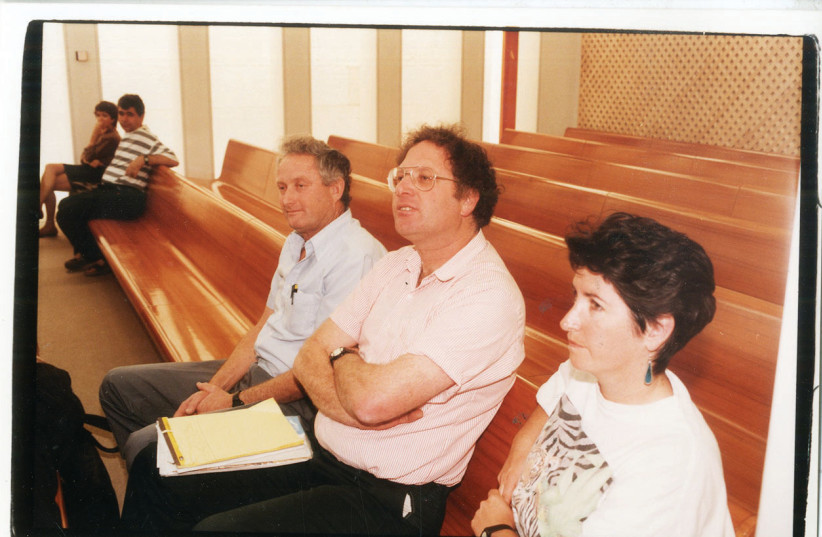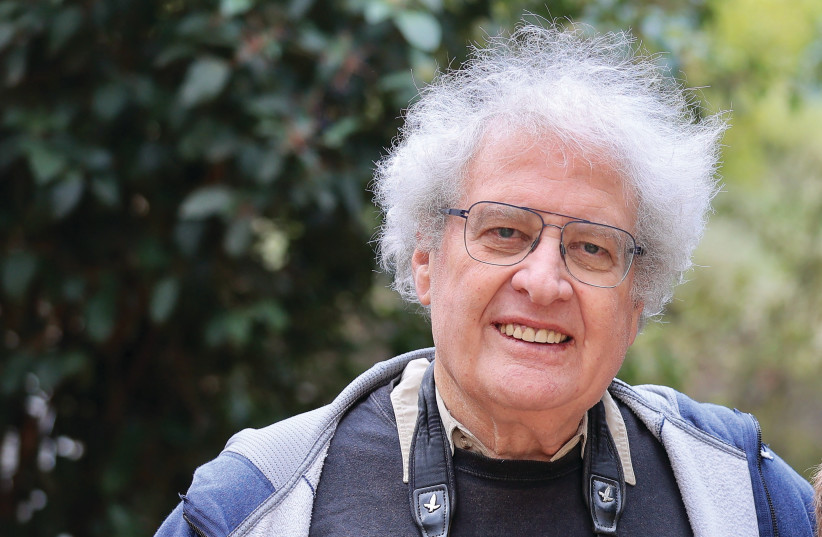What does Israel's chief birder think about birds of the Jewish state?

Prof. Yossi Leshem sat down recently with the Magazine to give his bird’s eye view of the avian populations that cross the Israeli skies.
“It all began with my mom,” says ornithologist Prof. Yossi Leshem, former executive director of the Society for the Protection of Nature in Israel (SPNI). “We lived in Haifa, and she would take my brother and me for hikes around Mount Carmel and instilled in us a love for nature. That’s when my love of birds began.”
When he was a child, he dreamed of being an Israel Air Force pilot, “since I wanted to be able to fly like a bird. But when I was in 11th grade and we began undergoing tests in the IDF recruitment process, the fact that I needed glasses made me ineligible for the Air Force pilots’ course. I still managed to log 2,300 flight hours, though, accompanying a pilot in a motorized glider. It’s such an incredible feeling to be gliding high up in the sky with the birds.”
Leshem recently published a book titled 50 Years of Birding in Israel. “Birds were the original Waze,” Leshem explains. “In many ways, birds are much more capable than humans – especially with their navigational capabilities. Our biggest success story involved a stork we called Princess. We attached a small transmitter to her, and we’ve been tracking her movements now for 13 years. It turns out that each year, she starts her migration from the same tree in a small town in Germany, flies over Israel, and completes her journey at the same tree in Cape Town. Every single year she follows the same exact path over this 11,000-km. route in both directions.
“We also know of an Arctic tern, a bird that each year migrates from the North Pole to the South Pole, completing a full circle around the planet. It usually takes her three weeks to travel these 78,000 km. at a speed of 50 km. an hour. The Arctic terns live on average for 20 years, which means that they fly about 1.5 million km. in total during their lifetime, without ever needing a tune-up or oil change.”
Leshem sat down recently with the Magazine to give his bird’s eye view of the avian populations that cross the Israeli skies.
Why are birds so important?
“First of all, when you’re standing outside and you look up and see birds flying high up in the sky, you get this amazing feeling. It’s not surprising that so many songs have been written about them. Secondly, birds play an important role in the food chain, since they eat insects and pests.
“In the Torah, birds are said to have been created on the fourth day of the story of creation. Many species of birds are mentioned in the Torah by name, such as eagles, storks, swallows, buzzards, kites, turtledoves, doves, nightingales, cranes, Egyptian vultures, quail, crows, night owls, hoopoes, barn owls and seagulls.”
According to Leshem, there are 560 types of birds in Israel, 400 of which he can identify. It is believed that more than a billion birds fly over Israel while they’re migrating each year.
“Israel is a paradise for ornithologists,” Leshem exclaims. “At the same time, this astronomical number of birds flying through Israel’s airspace is a nightmare for Israel’s Air Force. In 2003, the helicopter transporting Moshe Ya’alon, who was the IDF chief of staff at the time, had to make an emergency landing after a crane flew into its windshield. Three Israel Air Force pilots have died over the years due to collisions with birds.
“On the other hand, birds are also harmed from coming into contact with pesticides, electrical lines and Air Force helicopters that fly close to their nests.”
Do you think referring to the eagle as the “king of birds” is justified?
“Eagles have a wingspan of 2.5 m. They are known to be the ultimate gilder, since they are capable of flying through the sky without moving their wings at all. Some people call eagles nature’s clean-up crew because they eat carrion. And yet they have not survived well here in Israel. They numbered around 1,000 when Israel received its independence; this number has shrunk considerably. Currently, only 42 are still alive.”
What can you tell us about vultures, or ‘peres’ in Hebrew – according to which president Shimon Peres changed his name (he was born Perski)?
“Vultures have completely disappeared from Israel’s skies. The last pair of vultures was spotted in Israel 40 years ago in Nahal Mishmar, in the Judean Desert. It was not by coincidence that Peres chose to take the name of this majestic bird. He was a great bird lover.”
Why was the hoopoe chosen as Israel’s official national bird?
“Hoopoes, known in Hebrew as duchifat, live in Israel all year round. They have a distinctive crown of feathers and a distinctive call. They are also mentioned in the Bible, as King Solomon is said to have confided in a hoopoe, and then heeded its wise advice.
“The hoopoe also appears in another story from Jewish legend that takes place when the Temple was being built, and it was forbidden to use iron in its construction. Apparently, the hoopoe approached King Solomon with a worm called the shamir, and claimed he could cut through stones. The hoopoe has a gland at the base of its tail, where it kept the shamir, which can secrete a foul-smelling odor. The hoopoe can activate this gland any time it feels it is in danger.”
LESHEM, 75, studied at the yeshiva in Moshav Nehalim and served as an officer in the artillery corps, following which he transferred to the Israel Air Force. Leshem still serves as a lieutenant colonel in his IDF reserve duty. “I was brought in to manage a project aimed at preventing crashes between IDF airplanes and birds,” he explains.
After finishing his IDF service, Leshem completed a degree in biology at the Hebrew University of Jerusalem. In order to cover his expenses, he began working as an assistant to the bird taxidermist at the university. When asked whether he felt this work went against his love for birds, he replied, “Absolutely not. We never killed any birds. We only worked on birds that had already died.”
Leshem then completed an MA in zoology at Tel Aviv University, under the direction of Prof. Heinrich Mendelssohn, who is considered to be one of the top zoology specialists in Israel. One day, when he was touring the Jordan Valley, Leshem happened to catch on video a desert owl that had orange eyes, which is rarely seen.
“When I showed the video footage to Prof. Mendelssohn, he got so excited, like a kid receiving the best present in the world. ‘You’re the first person in the world to have filmed a desert owl with orange eyes,’ he enthused. ‘You must publish this finding in a scientific magazine.’”
Another exciting story took place when Leshem was tracking an eagle in the Nahal Dolev area, near Ramallah. “I was sent to Yigal Sela, an expert on birds of prey,” Leshem recalls. “‘Do you have any experience hanging from ropes off of a cliff?’ he asked me. I quickly and enthusiastically tied myself to the ropes in a way that today I realize was objectively pretty irresponsible. But at the time, the danger was farthest from my mind. And the risk paid off, as I captured the most incredible photographs of three chicks in their nest. I was so ecstatic; I felt like I’d been to heaven and back.”
Leshem also led educational tours at the Har Gilo Field School, and he formed an ornithology club for youth in Jerusalem. “I couldn’t believe that there was no ornithology club in a city in which so many birds lived,” he recalls. “The city didn’t have the funds to pay for such a group, so they sent me to speak with Teddy Kollek, the mayor of Jerusalem.
“After I explained to him the purpose of my visit, he told me, ‘Listen, my young friend. Jerusalem is about history and archaeology. Not birds.’ At which point I corrected him, saying, ‘Mr. Mayor, what you have here in Jerusalem is a paradise for birds.’
“Then he asked me, ‘What do you want from me?’ I asked him for a budget of 60,000 lira [the currency at that time]. I have no idea why that number popped into my head, but that’s what came out of my mouth. ‘You got it!’ Kollek replied. That settled the matter, and since then, generations of birders have benefited from this amazing ornithology club.”
Have local municipality figures been eager to help?
“Some were, and some weren’t. I approached Issawi Frej, the regional cooperation minister [in the last government], and asked for assistance with the joint Israel-Jordan barn-owl project. He just could not understand what I was talking about.
“But the minister did agree to go with me to Kibbutz Sde Eliyahu, where the program is taking place. The moment he picked up one of the barn owls, his eyes sparkled, and he approved my funding application on the spot. Interestingly, Muslims believe that barn owls bring bad luck.”
This project soon led Leshem to an hour-long meeting with Pope Francis, who is a strong supporter of programs aimed at preserving the planet. “Meeting with the pope was an extraordinary experience,” Leshem recounts. “Where the dove failed to bring peace, the barn owl might just succeed. I’m not so naïve, though, to believe that we can bring peace between our two countries from one small, albeit successful, joint venture.”
THROUGHOUT HIS career, Leshem has been involved in numerous bird-related ventures. He founded and was the director of the International Center for the Study of Bird Migration at Latrun, and spent 25 years at SPNI, including four years as the first kippah-wearing director.
In that role, Leshem led the fight against the placement of Voice of America transmitters in the Arava, “since we were afraid it would affect the birds’ navigational abilities. There are so many causes we need to support, especially since the penalties for harming nature are much too light.”
Now, as a father of five and grandfather of eight, Leshem can sit back and say, “I was so fortunate that my work was also my hobby,” he concludes. “Overall, I’m a pretty happy person.”
Translated by Hannah Hochner.
The Environment and Climate Change portal is produced in cooperation with the Goldman Sonnenfeldt School of Sustainability and Climate Change at Ben-Gurion University of the Negev. The Jerusalem Post maintains all editorial decisions related to the content.
Jerusalem Post Store
`; document.getElementById("linkPremium").innerHTML = cont; var divWithLink = document.getElementById("premium-link"); if (divWithLink !== null && divWithLink !== 'undefined') { divWithLink.style.border = "solid 1px #cb0f3e"; divWithLink.style.textAlign = "center"; divWithLink.style.marginBottom = "15px"; divWithLink.style.marginTop = "15px"; divWithLink.style.width = "100%"; divWithLink.style.backgroundColor = "#122952"; divWithLink.style.color = "#ffffff"; divWithLink.style.lineHeight = "1.5"; } } (function (v, i) { });


